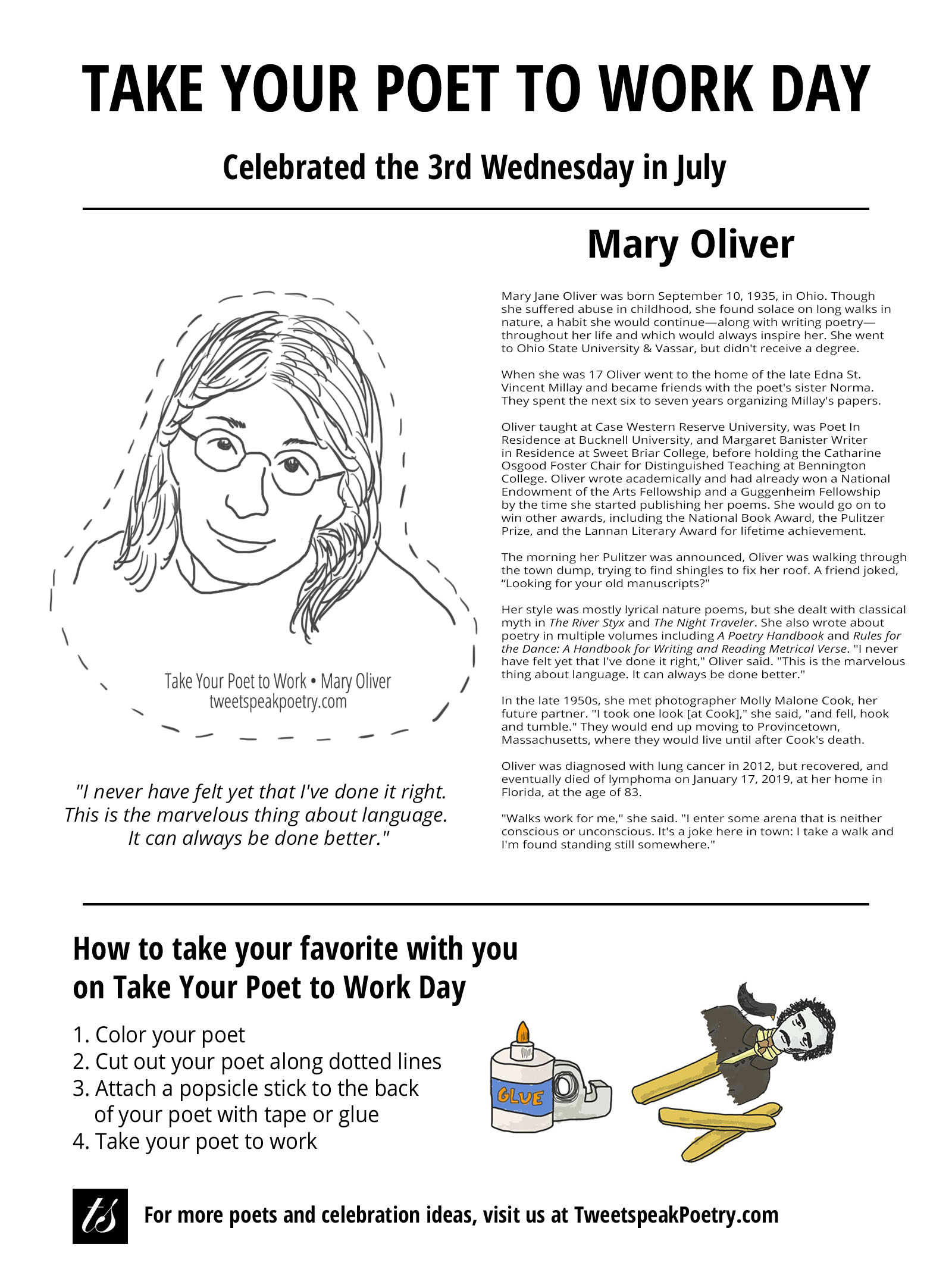Summer is one of the happiest seasons at Tweetspeak Poetry, because it is the season of Take Your Poet to Work Day (or, you know, to the beach). It’s one thing to start every day with a poem (we recommend it). But how great would it be to start your day with a poet? On Take Your Poet to Work Day, we encourage people around the world to take their favorite poet to work for the day.
Take Your Poet to Work Day is coming July 17, 2019
To help you play and celebrate with us, we’re releasing poets each week in a compact, convenient format you can tuck in your pocket, tool belt, or lunchbox.
We started our celebration five years ago with Sara Teasdale, Pablo Neruda, T. S. Eliot, Rumi, Edgar Allan Poe, and the reclusive Emily Dickinson (for folks who work at home).
We even released a full collection, The Haiku Masters: Matsuo Basho, Yosa Buson, and Kobayashi Issa.
In 2014, we added Langston Hughes, Adrienne Rich, John Keats, William Butler Yeats, Christina Rossetti and the beloved 20th-century American poet, Sylvia Plath.
In 2015, we introduced the Bard of Avon William Shakespeare, beloved poet Maya Angelou, and iconic American poet Robert Frost, Russian poet Anna Akhmatova, Polish poet Wisława Szymborska, and America’s poet, Walt Whitman.
In 2016, English Romantic poet William Wordsworth, joined in, along with Elizabeth Barrett Browning, Irish poet Seamus Heaney, and English poet and novelist Emily Brontë, Australian poet and activist Judith Wright, and Henry Wadsworth Longfellow.
Because you can never have too many poets in your lunch box (or your desk drawer), we also do a school-year celebration in April—Take Your Poet to School Week—with some favorites for the younger (and younger-at-heart) poetry readers: Shel Silverstein, Ogden Nash, Robert Louis Stevenson and the always delightful Mother Goose.
Last year, in 2018, we introduced Jorge Luis Borges, Rosalía de Castro, Sor Juana Inés de la Cruz, and Rosario Castellanos.
This year, we feature some of our recently lost American national treasures, like C.D. Wright, Tony Hoagland, and today’s new release, Mary Oliver.
Take Your Poet to Work: Mary Oliver
Mary Jane Oliver was born September 10, 1935, in Ohio. Though she suffered abuse in childhood, she found solace on long walks in nature, a habit she would continue—along with writing poetry—throughout her life and which would always inspire her.
Oliver went to Ohio State University & Vassar, but didn’t receive a degree. When she was 17 she went to the home of the late Edna St. Vincent Millay and became friends with the poet’s sister Norma. They spent the next six to seven years organizing Millay’s papers.
She taught at Case Western Reserve University, was Poet In Residence at Bucknell University, and Margaret Banister Writer in Residence at Sweet Briar College, before holding the Catharine Osgood Foster Chair for Distinguished Teaching at Bennington College. Oliver wrote academically and had already won a National Endowment of the Arts Fellowship and a Guggenheim Fellowship by the time she started publishing her poems. She would go on to win other awards, including the National Book Award, the Pulitzer Prize, and the Lannan Literary Award for lifetime achievement, for her poetry. Oliver said, “I was very careful never to take an interesting job. … I took lots of jobs. But if you have an interesting job you get interested in it.”
The morning her Pulitzer was announced, Oliver was walking through the town dump, trying to find shingles to fix her roof. A friend joked, “Looking for your old manuscripts?”
Her style was mostly lyrical nature poems, but she dealt with classical myth in The River Styx and The Night Traveler. She also wrote about poetry in multiple volumes including A Poetry Handbook and Rules for the Dance: A Handbook for Writing and Reading Metrical Verse. “I never have felt yet that I’ve done it right,” Oliver said. “This is the marvelous thing about language. It can always be done better.”
In the late 1950s, she met photographer Molly Malone Cook, her future partner. “I took one look [at Cook],” she said, “and fell, hook and tumble.” They would end up moving to Provincetown, Massachusetts, where they would live until after Cook’s death.
Oliver was diagnosed with lung cancer in 2012, but recovered, and eventually died of lymphoma on January 17, 2019, at her home in Florida, at the age of 83.
“Walks work for me,” she said. “I enter some arena that is neither conscious or unconscious. It’s a joke here in town: I take a walk and I’m found standing still somewhere.”
The Fish
The first fish
I ever caught
would not lie down
quiet in the pail
but flailed and sucked
at the burning
amazement of the air
and died
in the slow pouring off
of rainbows. Later
I opened his body and separated
the flesh from the bones
and ate him. Now the sea
is in me: I am the fish, the fish
glitters in me; we are
risen, tangled together, certain to fall
back to the sea. Out of pain,
and pain, and more pain
we feed this feverish plot, we are nourished
by the mystery.
—Mary Oliver
Get your own Mary Oliver — Take Your Poet to Work Printable that you can print, color, and cut out for the big day.
Illustrations by Will Willingham.
- Earth Song Poem Featured on The Slowdown!—Birds in Home Depot - February 7, 2023
- The Rapping in the Attic—Happy Holidays Fun Video! - December 21, 2022
- Video: Earth Song: A Nature Poems Experience—Enchanting! - December 6, 2022


Teri Petz says
What a great idea Will! I like the format of having the poets bio and a poem as well along with their picture.
L.L. Barkat says
Welcome, Teri. We’re so glad you like the format! 🙂